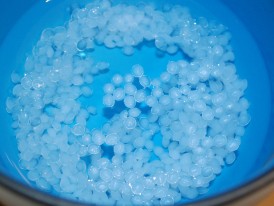One of the early upgrades I added to my mill was a dust shoe. It was a copy of a common design in the shapeoko community. It works, but I have issues with it. The design relies on a skirt, which is never the length you want and doesn’t work well with small parts and height changes. The other issue I have is that you can never see what is going on. Some have created designs with clear materials, but those will get dusty fast. Lastly the design restricts access to the collet locker. It makes bit changing a pain. In comes my savior, Loc-Line. First a picture of the finished product so we are all on the same page.  They sell 3/4″ Loc-Line for a reasonable price on amazon. I don’t recommend it however. The stuff has a large internal diameter, but the bend radius is not tight. I made an early version of this with the 3/4″ stuff and just couldn’t ever get the nozzle positioned how I wanted. Instead I recommend this 1/2″ kit from amazon. It comes with 12 segments, 3 different nozzle diameters, and two threaded NPT adapters. One is 1/2″ NPT and I think the other is 3/8″. I used two kits to outfit my mill.
They sell 3/4″ Loc-Line for a reasonable price on amazon. I don’t recommend it however. The stuff has a large internal diameter, but the bend radius is not tight. I made an early version of this with the 3/4″ stuff and just couldn’t ever get the nozzle positioned how I wanted. Instead I recommend this 1/2″ kit from amazon. It comes with 12 segments, 3 different nozzle diameters, and two threaded NPT adapters. One is 1/2″ NPT and I think the other is 3/8″. I used two kits to outfit my mill.
Now is one of the many times I really really want a 3D printer. I could print a perfect adapter to go from my tapered shop vacuum hose line to these Loc-Line threaded adapters. Also a 3D printer would let you print all manner of nozzles. Having some be flat bottomed or concave to sit around the bit would be ideal. Alas I have no 3D printer, but luckily PVC piping got me there. My shop vac line fits reasonably well into a 1″ PVC coupler, so I started with that. I found a great tee to go from 1″ to 3/4″ pipe, and a set of 3/4″ plugs with internal 1/2″ NPT pipe threads. Loc-Line threaded adapters go into those. Take a look:
Just for the fun of it I went ahead and painted the PVC tee blue. Why not add some color to life. A shaped piece of wood conforms to the spindle on one side and the PVC on the other, and a hose clamp holds it all together. I forgot to take a picture, but the SVG profile is below and you can see it painted red in the finished shot. 
 Looks stylish, has a lot of adjustability, easy to see what is happening, and easy bit access. Does it suck though? I shot some video while finding out. First I started by pocketing 1.2″ diameter hole as an easy test. Next I moved onto a deep profile cutout to see if it could suck debris from the bottom of a trench. As a bonus the nozzles hit the work surface. Being flexible they moved and didn’t interrupt the mill. I will probably chew up nozzles over time, but they are cheap enough. If I had a printer I could make my own on demand! Someday. Anywho, video time.
Looks stylish, has a lot of adjustability, easy to see what is happening, and easy bit access. Does it suck though? I shot some video while finding out. First I started by pocketing 1.2″ diameter hole as an easy test. Next I moved onto a deep profile cutout to see if it could suck debris from the bottom of a trench. As a bonus the nozzles hit the work surface. Being flexible they moved and didn’t interrupt the mill. I will probably chew up nozzles over time, but they are cheap enough. If I had a printer I could make my own on demand! Someday. Anywho, video time.









































 Screw together vigorously with epoxy coated exterior screws. Impact drivers help make stuff like this go quickly. I love my dewalt!
Screw together vigorously with epoxy coated exterior screws. Impact drivers help make stuff like this go quickly. I love my dewalt!





